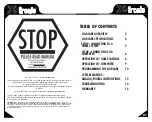
12
Discharge Control
The “trigger” switch is used to open and close the water/foam discharge valve. (This assumes the discharge valve has been wired to
the appropriate output on the Universal II) Squeezing the trigger switch will open the valve, and releasing the trigger switch will close
the valve. The valve may be placed in a continuously open condition by “double-clicking” the trigger switch. The next activation of the
trigger switch will return it to normal momentary operation.
Stream Pattern Control
On top of the joystick is a thumb switch used to control the pattern sleeve of the nozzle. Moving the thumb switch to the right
will move the pattern sleeve towards the straight stream position. Moving the thumb switch to the left will move the pattern sleeve
towards the fog position. In both cases, the pattern sleeve will stop when the thumb switch returns to center position, or the pattern
sleeve reaches the full extent of its travel. This permits a continuously adjustable discharge pattern.
For the 6035 ARFF Joystick, pattern control is accomplished using the two yellow buttons. The left button will move the nozzle toward
the fog pattern and the one on the right will move the nozzle toward the stream pattern when pressed.
SETUP AND CALIBRATION
Changes to the behavior of the joystick can be achieved by entering the setup mode. This can be done in the field with a small
magnet. Three small dots located on the connector label (see Figure 4) identify the location of Hall Effect switches inside the joystick.
Zeroing and Spanning the Joystick
Place a magnet over the Switch 1 dot for approximately one second (see Figure 4). All three LEDs will begin flashing the priority level
(the default will be three flashes). Momentarily place the magnet over Switch 3. The Green LED will begin flashing by itself signaling
the joystick has entered calibration mode. Allow the joystick to return to the centered position (at rest). Momentarily place the mag-
net over Switch 3. The Yellow LED will begin flashing by itself signaling the joystick has been zeroed. Move the joystick to any one of
its four corners (maximum X and Y deflection). While holding the joystick at its maximum, momentarily place a magnet over Switch 3.
At this point, all three LEDs will begin flashing the priority level signaling the joystick has been spanned.
Either cycling power or momentarily placing a magnet over Switch 2 will reset the joystick and return it to normal operation.
Changing the Priority Level
The SAE J1939/71 specification has made provisions for up to six joysticks residing on the same CAN bus (Joystick1 through Joystick6).
Akron Brass has chosen to interpret this assignment as the priority level. Joystick1 has the highest priority, and Joystick6 has the lowest
priority. A device at Joystick3 issuing “go right” messages would override a device at Joystick5 issuing “go left” messages. Akron Brass
has set the default for the 6041 CAN Switch Box at Joystick1, the 6035 CAN Joystick at Joystick3, and the 6037 CAN Wireless Interface
at Joystick5. Customers may require a different priority scheme. The following steps allow field changing of priority level.
Place a magnet over the Switch 1 dot for approximately one second (see Figure 4). All three LEDs will begin flashing the current priority
level (the default will be three flashes). Momentarily placing a magnet over Switch 1 again will increase the Joystick number (decrease
the priority) by one. Continue with momentarily placing a magnet over Switch 1 until the desired priority level has been reached.
When Joystick6 has been reached, another Switch 1 activation will wrap around to Joystick1. When the desired priority level has been
reached, momentarily place a magnet over Switch 2 to save the setting and the Joystick will reset and return to normal operation.
NOTE:
There cannot be two devices with the same priority level. If two devices are assigned the same priority level, only one will
remain active on the network. The remaining device will become inactive and claim CAN node address 254 as defined and
specified by SAE J1939.






























